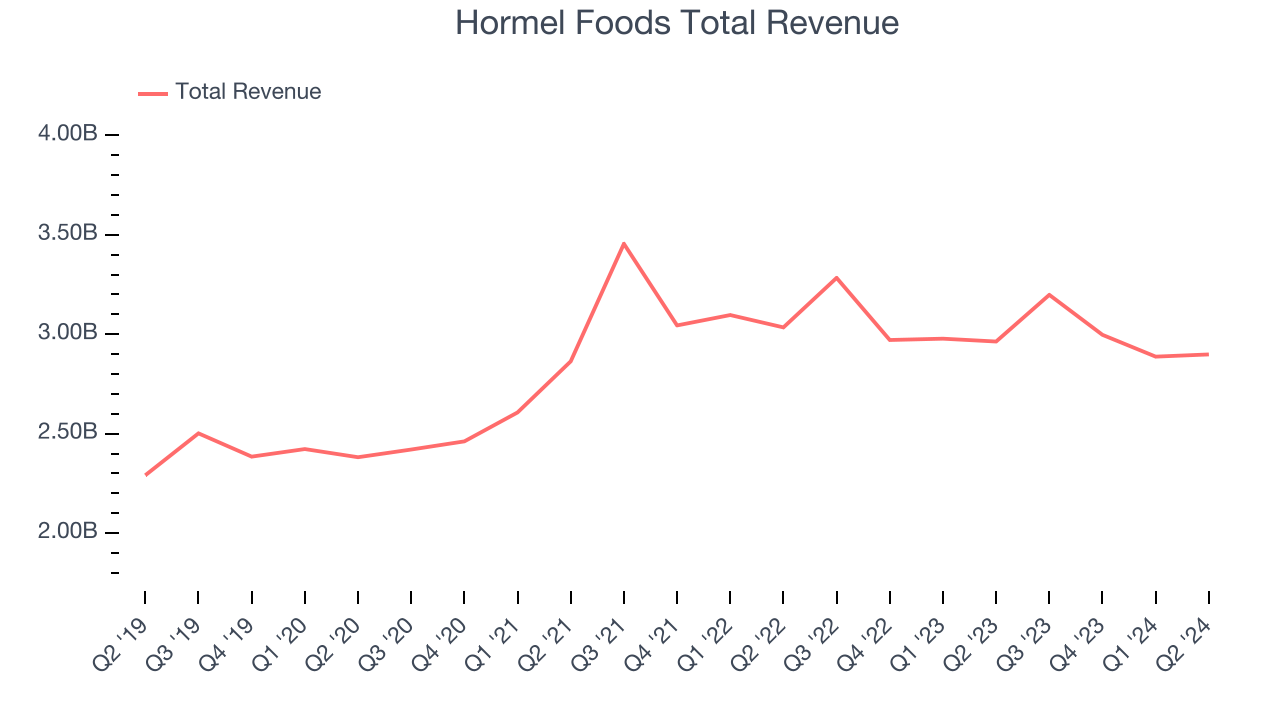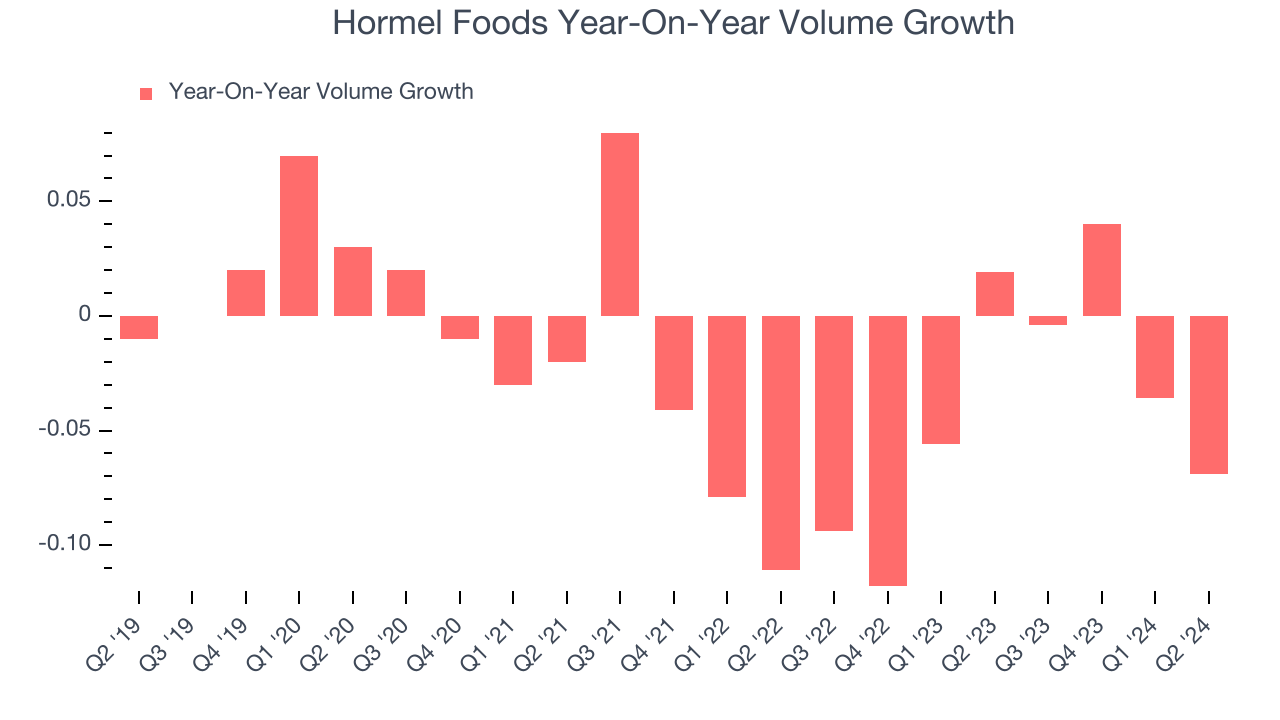Packaged foods company Hormel (NYSE:HRL) missed analysts’ expectations in Q2 CY2024, with revenue down 2.2% year on year to $2.90 billion. The company’s full-year revenue guidance of $11.95 billion at the midpoint also came in 1.5% below analysts’ estimates. It made a non-GAAP profit of $0.37 per share, down from its profit of $0.40 per share in the same quarter last year.
Is now the time to buy Hormel Foods? Find out by accessing our full research report, it’s free.
Hormel Foods (HRL) Q2 CY2024 Highlights:
- Revenue: $2.90 billion vs analyst estimates of $2.96 billion (2.2% miss)
- EPS (non-GAAP): $0.37 vs analyst expectations of $0.36 (in line)
- The company dropped its revenue guidance for the full year to $11.95 billion at the midpoint from $12.35 billion, a 3.2% decrease
- EPS (non-GAAP) guidance for the full year is $1.60 at the midpoint, roughly in line with what analysts were expecting
- Gross Margin (GAAP): 16.8%, in line with the same quarter last year
- EBITDA Margin: 10.4%, down from 12.1% in the same quarter last year
- Free Cash Flow Margin: 5.3%, down from 8.1% in the same quarter last year
- Sales Volumes fell 6.9% year on year (1.9% in the same quarter last year)
- Market Capitalization: $18.17 billion
Best known for its SPAM brand, Hormel (NYSE:HRL) is a packaged foods company with products that span meat, poultry, shelf-stable foods, and spreads.
Shelf-Stable Food
As America industrialized and moved away from an agricultural economy, people faced more demands on their time. Packaged foods emerged as a solution offering convenience to the evolving American family, whether it be canned goods or snacks. Today, Americans seek brands that are high in quality, reliable, and reasonably priced. Furthermore, there's a growing emphasis on health-conscious and sustainable food options. Packaged food stocks are considered resilient investments. People always need to eat, so these companies can enjoy consistent demand as long as they stay on top of changing consumer preferences. The industry spans from multinational corporations to smaller specialized firms and is subject to food safety and labeling regulations.
Sales Growth
Hormel Foods is one of the larger consumer staples companies and benefits from a well-known brand, giving it customer mindshare and influence over purchasing decisions.
As you can see below, the company’s annualized revenue growth rate of 5% over the last three years was sluggish for a consumer staples business.

This quarter, Hormel Foods missed Wall Street’s estimates and reported a rather uninspiring 2.2% year-on-year revenue decline, generating $2.90 billion in revenue. Looking ahead, Wall Street expects sales to grow 2.5% over the next 12 months, an acceleration from this quarter.
Today’s young investors won’t have read the timeless lessons in Gorilla Game: Picking Winners In High Technology because it was written more than 20 years ago when Microsoft and Apple were first establishing their supremacy. But if we apply the same principles, then enterprise software stocks leveraging their own generative AI capabilities may well be the Gorillas of the future. So, in that spirit, we are excited to present our Special Free Report on a profitable, fast-growing enterprise software stock that is already riding the automation wave and looking to catch the generative AI next.
Volume Growth
Revenue growth can be broken down into changes in price and volume (the number of units sold). While both are important, volume is the lifeblood of a successful staples business as there’s a ceiling to what consumers will pay for everyday goods; they can always trade down to non-branded products if the branded versions are too expensive.
Hormel Foods’s average quarterly sales volumes have shrunk by 4% over the last two years. This decrease isn’t ideal because the quantity demanded for consumer staples products is typically stable.

In Hormel Foods’s Q2 2024, sales volumes dropped 6.9% year on year. This result was a reversal from the 1.9% year-on-year increase it posted 12 months ago. A one quarter hiccup shouldn’t deter you from investing in a business. We’ll be monitoring the company to see how things progress.
Key Takeaways from Hormel Foods’s Q2 Results
It was encouraging to see Hormel Foods slightly top analysts’ gross margin expectations this quarter. On the other hand, its revenue unfortunately missed analysts’ expectations and its full-year revenue guidance missed Wall Street’s estimates. Overall, this was a mediocre quarter. The stock traded down 4.3% to $31.71 immediately after reporting.
Hormel Foods may have had a tough quarter, but does that actually create an opportunity to invest right now? When making that decision, it’s important to consider its valuation, business qualities, as well as what has happened in the latest quarter. We cover that in our actionable full research report which you can read here, it’s free.
